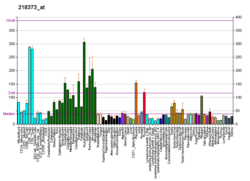AKTIP
AKT-interacting protein is a protein that in humans is encoded by the AKTIP gene.[5][6][7]
The mouse homolog of this gene produces fused toes and thymic hyperplasia in heterozygous mutant animals while homozygous mutants die in early development. This gene may play a role in apoptosis as these morphological abnormalities are caused by altered patterns of programmed cell death. The protein encoded by this gene is similar to the ubiquitin ligase domain of other ubiquitin-conjugating enzymes but lacks the conserved cysteine residue that enables those enzymes to conjugate ubiquitin to the target protein. This protein interacts directly with serine/threonine kinase protein kinase B (PKB)/Akt and modulates PKB activity by enhancing the phosphorylation of PKB's regulatory sites. Alternative splicing results in two transcript variants encoding the same protein.[7]
Interactions
Molecular genetics
The association between the AKTIP gene variants in a sample of 273 bipolar patients using 3 single-nucleotide polymorphisms has been investigated. No association between suicidal behavior and AKTIP variants nor any interaction between AKTIP and AKT1 polymorphisms was observed.[9]
References
- 1 2 3 GRCh38: Ensembl release 89: ENSG00000166971 - Ensembl, May 2017
- 1 2 3 GRCm38: Ensembl release 89: ENSMUSG00000031667 - Ensembl, May 2017
- ↑ "Human PubMed Reference:".
- ↑ "Mouse PubMed Reference:".
- ↑ Fluhmann B, Muff R, Hunziker W, Fischer JA, Born W (Feb 1995). "A human orphan calcitonin receptor-like structure". Biochem Biophys Res Commun. 206 (1): 341–7. doi:10.1006/bbrc.1995.1047. PMID 7818539.
- ↑ Aiyar N, Rand K, Elshourbagy NA, Zeng Z, Adamou JE, Bergsma DJ, Li Y (Jun 1996). "A cDNA encoding the calcitonin gene-related peptide type 1 receptor". J Biol Chem. 271 (19): 11325–9. doi:10.1074/jbc.271.19.11325. PMID 8626685.
- 1 2 "Entrez Gene: AKTIP AKT interacting protein".
- ↑ Remy, Ingrid; Michnick Stephen W (Feb 2004). "Regulation of apoptosis by the Ft1 protein, a new modulator of protein kinase B/Akt". Mol. Cell. Biol. United States. 24 (4): 1493–504. doi:10.1128/MCB.24.4.1493-1504.2004. ISSN 0270-7306. PMC 344167. PMID 14749367.
- ↑ Magno LA, Miranda DM, Neves FS, Pimenta GJ, Mello MP, De Marco LA, Correa H, Romano-Silva MA (January 2010). "Association between AKT1 but not AKTIP genetic variants and increased risk for suicidal behavior in bipolar patients". Genes Brain Behav. 9 (4): 411–8. doi:10.1111/j.1601-183X.2010.00571.x. PMID 20132317.
External links
- Human AKTIP genome location and AKTIP gene details page in the UCSC Genome Browser.
Further reading
- Maruyama K, Sugano S (1994). "Oligo-capping: a simple method to replace the cap structure of eukaryotic mRNAs with oligoribonucleotides". Gene. 138 (1–2): 171–4. doi:10.1016/0378-1119(94)90802-8. PMID 8125298.
- Suzuki Y, Yoshitomo-Nakagawa K, Maruyama K, et al. (1997). "Construction and characterization of a full length-enriched and a 5'-end-enriched cDNA library". Gene. 200 (1–2): 149–56. doi:10.1016/S0378-1119(97)00411-3. PMID 9373149.
- Lesche R, Peetz A, van der Hoeven F, Rüther U (1998). "Ft1, a novel gene related to ubiquitin-conjugating enzymes, is deleted in the Fused toes mouse mutation". Mamm. Genome. 8 (12): 879–83. doi:10.1007/s003359900604. PMID 9383278.
- Lesche R, Rüther U (1998). "Close linkage of p130 and Ft1 is conserved among mammals". Mamm. Genome. 9 (3): 253–5. doi:10.1007/s003359900737. PMID 9501314.
- Strausberg RL, Feingold EA, Grouse LH, et al. (2003). "Generation and initial analysis of more than 15,000 full-length human and mouse cDNA sequences". Proc. Natl. Acad. Sci. U.S.A. 99 (26): 16899–903. Bibcode:2002PNAS...9916899M. doi:10.1073/pnas.242603899. PMC 139241. PMID 12477932.
- Ota T, Suzuki Y, Nishikawa T, et al. (2004). "Complete sequencing and characterization of 21,243 full-length human cDNAs". Nat. Genet. 36 (1): 40–5. doi:10.1038/ng1285. PMID 14702039.
- Remy I, Michnick SW (2004). "Regulation of apoptosis by the Ft1 protein, a new modulator of protein kinase B/Akt". Mol. Cell. Biol. 24 (4): 1493–504. doi:10.1128/MCB.24.4.1493-1504.2004. PMC 344167. PMID 14749367.
- Gerhard DS, Wagner L, Feingold EA, et al. (2004). "The status, quality, and expansion of the NIH full-length cDNA project: the Mammalian Gene Collection (MGC)". Genome Res. 14 (10B): 2121–7. doi:10.1101/gr.2596504. PMC 528928. PMID 15489334.
- Stelzl U, Worm U, Lalowski M, et al. (2005). "A human protein-protein interaction network: a resource for annotating the proteome". Cell. 122 (6): 957–68. doi:10.1016/j.cell.2005.08.029. PMID 16169070.
- Rual JF, Venkatesan K, Hao T, et al. (2005). "Towards a proteome-scale map of the human protein-protein interaction network". Nature. 437 (7062): 1173–8. Bibcode:2005Natur.437.1173R. doi:10.1038/nature04209. PMID 16189514.
- Ewing RM, Chu P, Elisma F, et al. (2007). "Large-scale mapping of human protein-protein interactions by mass spectrometry". Mol. Syst. Biol. 3 (1): 89. doi:10.1038/msb4100134. PMC 1847948. PMID 17353931.




